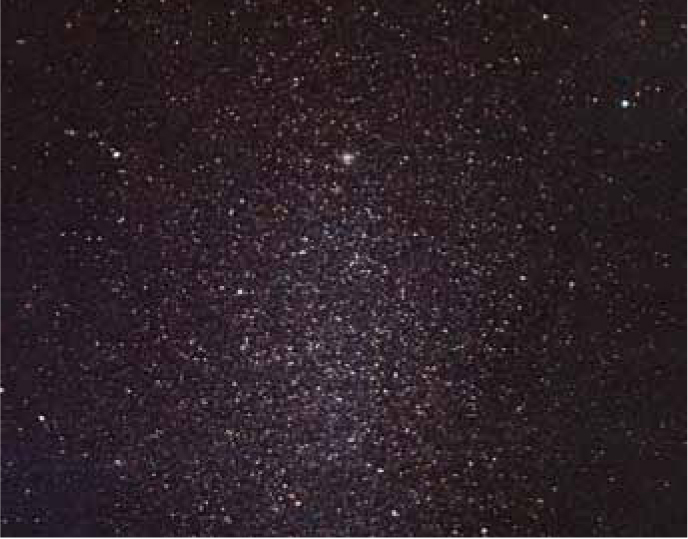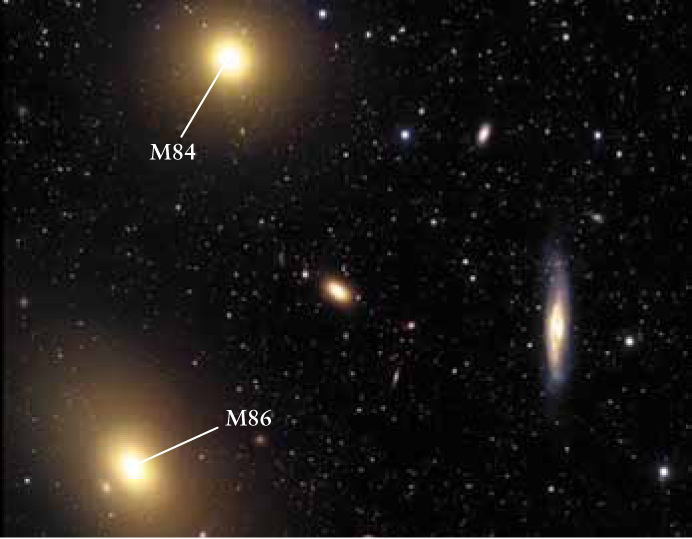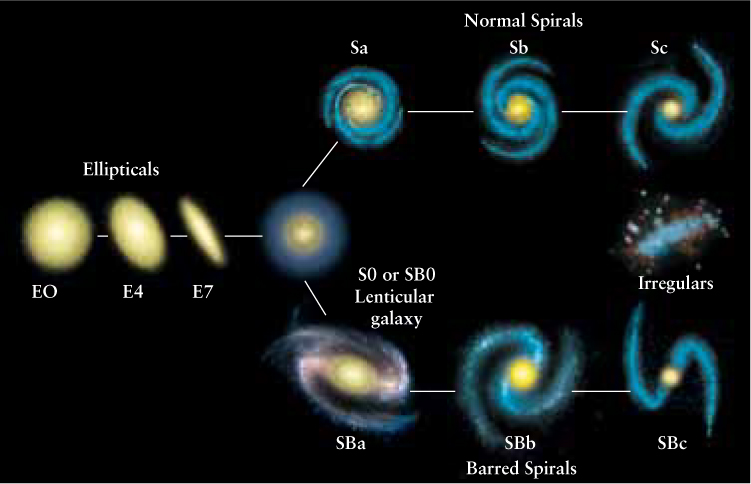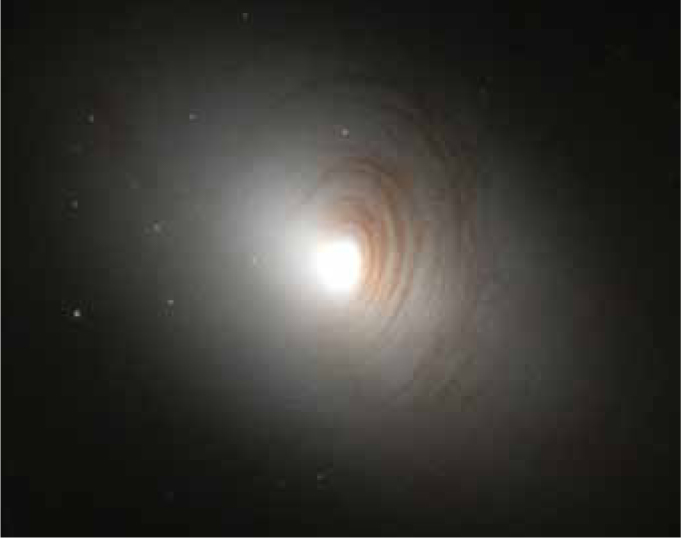23-3 Galaxies are classified according to their appearance
Millions of galaxies are visible across every unobscured part of the sky. Although all galaxies are made up of large numbers of stars, they come in a variety of shapes and sizes.
 Hubble classified galaxies into four broad categories based on their appearance. These categories form the basis for the Hubble classification, a scheme that is still used today. The four classes of galaxies are the spirals, classified S; barred spirals, or SB; ellipticals, E; and irregulars, Irr. Table 23-1 summarizes some key properties of each class. These various types of galaxies differ not only in their shapes but also in the kinds of processes taking place within them.
Hubble classified galaxies into four broad categories based on their appearance. These categories form the basis for the Hubble classification, a scheme that is still used today. The four classes of galaxies are the spirals, classified S; barred spirals, or SB; ellipticals, E; and irregulars, Irr. Table 23-1 summarizes some key properties of each class. These various types of galaxies differ not only in their shapes but also in the kinds of processes taking place within them.
| Spiral (S) and barred spiral (SB) galaxies | Elliptical galaxies (E) | Irregular galaxies (Irr) | |
|---|---|---|---|
| Mass (M⊙) | 109 to 4 × 1011 | 105 to 1013 | 108 to 3 × 1010 |
| Luminosity (L⊙) | 108 to 2 × 1010 | 3 × 105 to 1011 | 107 to 109 |
| Diameter (kpc) | 5 to 250 | 1 to 200 | 1 to 10 |
| Stellar populations | Spiral arms: young Population I Nucleus and throughout disk: Population II and old Population I | Population II and old Population I | mostly Population 1 |
| Percentage of observed galaxies | 77% | 20%* | 3% |
| *This percentage does not include dwarf elliptical galaxies that are as yet too dim and distant to detect. Hence, the actual percentage of galaxies that are ellipticals may be higher than shown here. | |||
Spiral Galaxies: Stellar Birthplaces
 M51 (Figure 23-2), M31 (Figure 23-3), and M100 (Figure 23-4) are examples of spiral galaxies. Figure 23-5 shows that spiral galaxies are characterized by arched lanes of stars, just as is our own Milky Way Galaxy (see Section 22-3). The spiral arms contain young, hot, blue stars and their associated H II regions, indicating ongoing star formation.
M51 (Figure 23-2), M31 (Figure 23-3), and M100 (Figure 23-4) are examples of spiral galaxies. Figure 23-5 shows that spiral galaxies are characterized by arched lanes of stars, just as is our own Milky Way Galaxy (see Section 22-3). The spiral arms contain young, hot, blue stars and their associated H II regions, indicating ongoing star formation.

Spiral Galaxies Edwin Hubble classified spiral galaxies according to the texture of their spiral arms and the relative size of their central bulges. Sa galaxies have smooth, broad spiral arms and the largest central bulges, while Sc galaxies have narrow, well-defined arms and the smallest central bulges.
Thermonuclear reactions within stars create metals, that is, elements heavier than hydrogen or helium (see Section 17-5). These metals are dispersed into space as the stars evolve and die. So, if new stars are being formed from the interstellar matter in spiral galaxies, they will incorporate these metals and be Population I stars (see Section 19-5 and Section 22-2). Indeed, the visible-light spectrum of the disk of a spiral galaxy has strong metal absorption lines. Such a spectrum is a composite of the spectra of many stars and shows that the stars in the disk are principally of Population I. By contrast, there is relatively little star formation in the central bulges of spiral galaxies, and these regions are dominated by old Population II stars that have a low metal content. The lack of star formation also explains why the central bulges of spiral galaxies have a yellowish or reddish color; as a population of stars ages, the massive, luminous blue stars die off first, leaving only the longer-lived, low-mass red stars.
Hubble further classified spiral galaxies according to the texture of the spiral arms and the relative size of the central bulge. Spirals with smooth, broad spiral arms and a fat central bulge are called Sa galaxies, for spiral type a (Figure 23-5a); those galaxies with moderately well-defined spiral arms and a moderate-sized central bulge, like M31 and M51, are Sb galaxies (Figure 23-5b); and galaxies with narrow, well-defined spiral arms and a tiny central bulge are Sc galaxies (Figure 23-5c).
The differences between Sa, Sb, and Sc galaxies may be related to the relative amounts of gas and dust they contain. Observations with infrared telescopes (which detect the emission from interstellar dust) and radio telescopes (which detect radiation from interstellar gases such as hydrogen and carbon monoxide) show that about 4% of the mass of a Sa galaxy is in the form of gas and dust. This percentage is 8% for Sb galaxies and 25% for Sc galaxies.
Interstellar gas and dust is the material from which new stars are formed, so an Sc galaxy has a greater proportion of its mass involved in star formation than an Sb or Sa galaxy. Hence, a Sc galaxy has a large disk (where star formation occurs) and a small central bulge (where there is little or no star formation). By comparison, a Sa galaxy, which has relatively little gas and dust, and thus less material from which to form stars, has a large central bulge and only a small star-forming disk.
The central bulge contains more than just stars: It is also thought to contain a supermassive black hole at its center. The mass of the black hole is about 1/1000 the mass of the central bulge, which corresponds to black hole masses of millions to hundreds of millions of solar masses. (The mass of the black hole at the center of our Milky Way is just over 4 million solar masses.) Chapter 24 discusses how these black holes are the “central engines” of quasars and active galaxies.
CONCEPT CHECK 23-3
When making a sketch of a spiral galaxy with considerable star formation, which areas would you label with more star formation? Which areas would have less?
Sc galaxies have the most active star formation, so a sketch would have a smaller central bulge and a relatively large star-forming disk with considerable gas and dust.
Barred Spiral Galaxies: Spirals with an Extra Twist
In barred spiral galaxies, such as those shown in Figure 23-6, the spiral arms originate at the ends of a bar-shaped region running through the galaxy’s nucleus rather than from the nucleus itself. As with ordinary spirals, Hubble subdivided barred spirals according to the relative size of their central bulge and the character of their spiral arms. A SBa galaxy has a large central bulge and thin, tightly wound spiral arms (Figure 23-6a). Likewise, a SBb galaxy is a barred spiral with a moderate central bulge and moderately wound spiral arms (Figure 23-6b), while a SBc galaxy has lumpy, loosely wound spiral arms and a tiny central bulge (Figure 23-6c). As for ordinary spiral galaxies, the difference between SBa, SBb, and SBc galaxies may be related to the amount of gas and dust in the galaxy.

Barred Spiral Galaxies As with spiral galaxies, Hubble classified barred spirals according to the texture of their spiral arms (which correlates to the sizes of their central bulges). SBa galaxies have the smoothest spiral arms and the largest central bulges, while SBc galaxies have narrow, well-defined arms and the smallest central bulges.
Bars appear to form naturally in many spiral galaxies. This conclusion comes from computer simulations of galaxies, which set hundreds of thousands of simulated “stars” into orbit around a common center. As the “stars” orbit and exert gravitational forces on one another, a bar structure forms in most cases. Indeed, barred spiral galaxies outnumber ordinary spirals by about two to one. (As we saw in Section 22-2, there is evidence that the Milky Way Galaxy is a barred spiral.)
Why don’t all spiral galaxies have bars? According to calculations by Jeremiah Ostriker and P. J. E. Peebles of Princeton University, a bar will not develop if a galaxy is surrounded by a sufficiently massive halo of nonluminous dark matter. (In Section 22-4 we saw evidence that our Milky Way Galaxy is surrounded by such a dark matter halo.) The difference between barred spirals and ordinary spirals may thus lie in the amount of dark matter the galaxy possesses. In Section 23-8 we will see compelling evidence for the existence of dark matter in spiral galaxies.
CONCEPT CHECK 23-4
How are galaxies with loosely wrapped arms categorized using Hubble’s scheme?
In both spiral and barred spirals, the designation a is used for tightly wound arms and c for loosely wrapped arms.
Elliptical Galaxies: From Giants to Dwarfs
Elliptical galaxies, so named because of their distinctly elliptical shapes, have no spiral arms. Hubble subdivided these galaxies according to how round or flattened they look. The roundest elliptical galaxies are called E0 galaxies and the flattest, E7 galaxies. Elliptical galaxies with intermediate amounts of flattening are given designations between these extremes (Figure 23-7).

Elliptical Galaxies Hubble classified elliptical galaxies according to how round or flattened they look. A galaxy that appears round is labeled E0, and the flattest-appearing elliptical galaxies are designated E7.
CAUTION!
Unlike the designations for spirals and barred spirals, the classifications E0 through E7 may not reflect the true shape of elliptical galaxies. An E1 or E2 galaxy might actually be a very flattened disk of stars that we just happen to view face-on, and a cigar-shaped E7 galaxy might look spherical if seen end-on. The Hubble scheme classifies galaxies entirely by how they appear to us on Earth.
Elliptical galaxies look far less dramatic than their spiral and barred spiral cousins. The reason, as shown by radio and infrared observations, is that ellipticals are virtually devoid of interstellar gas and dust. Consequently, there is little material from which stars could have recently formed, and indeed there is no evidence of young stars in most elliptical galaxies. For the most part, star formation in elliptical galaxies ended long ago. Hence, these galaxies are composed of old, red, Population II stars with only small amounts of metals.
Elliptical galaxies come in a wide range of sizes and masses. Both the largest and the smallest galaxies in the known universe are elliptical. Figure 23-8 shows two giant elliptical galaxies that are about 20 times larger than an average galaxy. These giant ellipticals are located near the middle of a large cluster of galaxies in the constellation Virgo. (We will discuss this and other clusters of galaxies in Section 23-6.)

A Dwarf Elliptical Galaxy This diffuse cloud of stars is a nearby E4 dwarf elliptical called Leo I. It actually orbits the Milky Way at a distance of about 180 kpc (600,000 ly). Leo I is about 1 kpc (3000 ly) in diameter but contains so few stars that you can see through the galaxy’s center.

Giant Elliptical Galaxies The Virgo cluster is a rich, sprawling collection of more than 2000 galaxies about 17 Mpc (56 million ly) from Earth. Only the center of this huge cluster appears in this photograph. The two largest members of this cluster are the giant elliptical galaxies M84 and M86. These galaxies have angular sizes of 5 to 7 arcmin.
Giant ellipticals are rather rare, but dwarf elliptical galaxies are quite common. Dwarf ellipticals are only a fraction the size of their normal counterparts and contain so few stars—only a few million, compared to more than 100 billion (1011) stars in our Milky Way Galaxy—that these galaxies are completely transparent. You can actually see straight through the center of a dwarf galaxy and out the other side, as Figure 23-9 shows.
The visible light from a galaxy is emitted by its stars, so the visible-light spectrum of a galaxy has absorption lines. But because a galaxy’s stars are in motion, with some approaching us and others moving away, the Doppler effect smears out and broadens the absorption lines. The average motions of stars in a galaxy can be deduced from the details of this broadening.
For elliptical galaxies, studies of this kind show that star motions are quite random. In a very round (E0) elliptical galaxy, this randomness is isotropic, meaning “equal in all directions.” Because the stars are whizzing around equally in all directions, the galaxy is genuinely spherical. In a flattened (E7) elliptical galaxy, the randomness of the stellar motions is anisotropic, which means that the range of star speeds is different in different directions.
Hubble also identified galaxies that are midway in appearance between ellipticals and the two kinds of spirals. These are denoted as S0 and SB0 galaxies, also called lenticular galaxies. Although they look somewhat elliptical, lenticular (“lens-shaped”) galaxies have both a central bulge and a disk like spiral galaxies, but no discernible spiral arms. They are therefore sometimes referred to as “armless spirals.” Figure 23-10 shows an example of an SB0 lenticular galaxy.


A Lenticular Galaxy NGC 2787 is classified as a lenticular galaxy because it has a disk but no discernible spiral arms. Its nucleus displays a faint bar (not apparent in this image), so NGC 2787 is denoted as an SB0 galaxy. It lies about 7.4 Mpc (24 million ly) from Earth in the constellation Ursa Major.
Edwin Hubble summarized his classification scheme for spiral, barred spiral, and elliptical galaxies in a diagram, now called the tuning fork diagram for its shape (Figure 23-11).
CAUTION!
When Hubble first drew his tuning fork diagram, he had the idea that it represented an evolutionary sequence. He thought that galaxies evolved over time from the left to the right of the diagram, beginning as ellipticals and eventually becoming either spiral or barred spiral galaxies. We now understand that this evolution of galaxies is not the case at all! For one thing, elliptical galaxies have little or no overall rotation, while spiral and barred spiral galaxies have a substantial amount of overall rotation. There is no way that an elliptical galaxy could suddenly start rotating, which means that it could not evolve into a spiral galaxy.
A more modern interpretation of the Hubble tuning fork diagram is that it is an arrangement of galaxies according to their overall rotation. A rapidly rotating collection of matter in space tends to form a disk, while a slowly rotating collection does not. Thus, the elliptical galaxies at the far left of the tuning fork diagram have little internal rotation and hence no disk. Sa and SBa galaxies have enough overall rotation to form a disk, though their central bulges are still dominant. The galaxies with the greatest amount of overall rotation are Sc and SBc galaxies, in which the central bulges are small and most of the gas, dust, and stars are in the disk.
Irregular Galaxies: Deformed and Dynamic
Galaxies that do not fit into the scheme of spirals, barred spirals, and ellipticals are usually referred to as irregular galaxies. They are generally rich in interstellar gas and dust, and have both young and old stars. For lack of any better scheme, the irregular galaxies are sometimes placed between the ends of the tines of the Hubble tuning fork diagram, as in Figure 23-11.
Hubble defined two types of irregulars. Irr I galaxies have only hints of organized structure, and have many OB associations and H II regions. The best-known examples of Irr I galaxies are the Large Magellanic Cloud (Figure 23-12) and the Small Magellanic Cloud. Both are nearby companions of our Milky Way and can be seen with the naked eye from southern latitudes. Both these galaxies contain substantial amounts of interstellar gas. Tidal forces exerted on these irregular galaxies by the Milky Way help to compress the gas, which is why both of the Magellanic clouds are sites of active star formation.

The Large Magellanic Cloud (LMC) At a distance of only 55 kpc (179,000 ly), this Irr I galaxy is the third closest known companion of our Milky Way Galaxy. About 19 kpc (62,000 ly) across, the LMC spans 22° across the sky, or about 50 times the size of the full moon. One sign that star formation is ongoing in the LMC is the Tarantula Nebula, whose diameter of 250 pc (800 ly) and mass of 5 × 106 M☉ make it the largest known H II region.
The other type of irregulars, called Irr II galaxies, have asymmetrical, distorted shapes that seem to have been caused by collisions with other galaxies or by violent activity in their nuclei. M82, shown in Figure 21-16 and in the image that opens Chapter 6, is an example of an Irr II galaxy.
CONCEPT CHECK 23-5
Which type of galaxy has almost no ongoing active star formation?
Elliptical galaxies have almost no gas or dust available for the formation of stars.